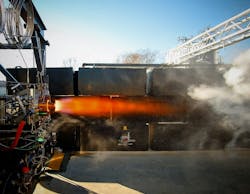Venus Aerospace debuts hypersonic detonation ramjet engine
HOUSTON - Venus Aerospace in Houston has introduced its latest propulsion system, the VDR2, designed to power high-speed vehicles such as drones and aircraft. The engine is engineered for long-range travel at high altitudes and can reach speeds of up to Mach 6.
The VDR2 integrates two technologies: the Rotating Detonation Rocket Engine (RDRE), which provides high thrust, and a ramjet, which ensures efficient cruising. This combination allows the engine to operate from takeoff through hypersonic speeds without the need for complex mechanical systems. The VDR2 engine is expected to take flight in Venus Aerospace’s hypersonic test drone in 2025.
“This engine makes the hypersonic economy a reality,” said Dr. Andrew Duggleby, co-founder of Venus Aerospace, during the unveiling at Up.Summit. “We are excited to partner with Velontra to achieve this revolution in high-speed flight, given their expertise in high-speed air combustion.”
Related: NASA seeks industry input on rotating detonation rocket engine development
Velontra’s Chief Operating Officer Eric Briggs expressed enthusiasm for the partnership, stating, “We can’t wait to dig in, make the first one fly, and ultimately perfect an engine concept that has lived mostly in textbooks but never as a production unit in the air. We couldn’t think of a better partner than Venus.
Venus plans to equip its RDRE on its commercial hypersonic aircraft, the Stargazer M400. Venus says the aircraft will cruise at Mach 4 at 110,000 feet of elevation and have a top speed of Mach 9.
The plane would use advanced propulsion systems to take off from regular runways, reach the edge of space, and cruise at extremely high altitudes before landing at its destination. Stargazer reflects Venus Aerospace's vision to transform high-speed travel with reusable technology, with applications for both commercial and defense purposes.
Earlier this year, Venus and the National Aeronautics and Space Administration (NASA) announced a partnership to test RDREs in a flight-like manner. The engine injector that Venus Aerospace designed and provided was the highest performing and sustained the longest detonation engine run of the entire campaign. Using a regeneratively-cooled RDRE architecture, the engine successfully operated for 4 minutes of hotfire testing. Most engine tests of this type last for only 1-2 seconds. This long-duration hotfire means RDRE's have retired a major risk area and can move into the few remaining steps before a flight demonstration.NASA is considering using RDREs for in-space applications such as lunar and martian landers, in-space operations and logistics, and other deep-space missions.
About the Author
Jamie Whitney
Senior Editor
Jamie Whitney joined the staff of Military & Aerospace Electronics in 2018 and oversees editorial content and produces news and features for Military & Aerospace Electronics, attends industry events, produces Webcasts, and oversees print production of Military & Aerospace Electronics.
